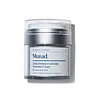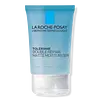What's inside
What's inside
 Key Ingredients
Key Ingredients

 Benefits
Benefits

 Concerns
Concerns

 Ingredients Side-by-side
Ingredients Side-by-side

Colloidal Oatmeal 1%
AbsorbentWater
Skin ConditioningGlycerin
HumectantButyrospermum Parkii Butter
Skin ConditioningPropanediol
SolventCaprylic/Capric Triglyceride
MaskingGlyceryl Stearate
EmollientAvena Sativa Kernel Flour
AbrasiveAvena Sativa Kernel Extract
AbrasiveBetaine
HumectantOphiopogon Japonicus Root Extract
Skin ConditioningNiacinamide
SmoothingHydrogenated Lecithin
EmulsifyingEthylhexylglycerin
Skin ConditioningMaltodextrin
AbsorbentCetearyl Alcohol
EmollientCetearyl Glucoside
EmulsifyingLauryl Laurate
Skin ConditioningCetyl Myristate
EmollientSodium Polyacrylate Starch
AbsorbentCarbomer
Emulsion StabilisingHectorite
AbsorbentCaprylhydroxamic Acid
Tetrasodium Glutamate Diacetate
Sodium Hydroxide
BufferingChlorphenesin
AntimicrobialColloidal Oatmeal 1%, Water, Glycerin, Butyrospermum Parkii Butter, Propanediol, Caprylic/Capric Triglyceride, Glyceryl Stearate, Avena Sativa Kernel Flour, Avena Sativa Kernel Extract, Betaine, Ophiopogon Japonicus Root Extract, Niacinamide, Hydrogenated Lecithin, Ethylhexylglycerin, Maltodextrin, Cetearyl Alcohol, Cetearyl Glucoside, Lauryl Laurate, Cetyl Myristate, Sodium Polyacrylate Starch, Carbomer, Hectorite, Caprylhydroxamic Acid, Tetrasodium Glutamate Diacetate, Sodium Hydroxide, Chlorphenesin
Water
Skin ConditioningGlycerin
HumectantSilica
AbrasiveBetaine
HumectantNiacinamide
SmoothingCetearyl Isononanoate
EmollientZea Mays Starch
AbsorbentCeramide NP
Skin ConditioningCarbomer
Emulsion StabilisingGlyceryl Stearate Citrate
EmollientSodium Hyaluronate
HumectantSodium Hydroxide
BufferingPerlite
AbsorbentHydroxyacetophenone
AntioxidantCaprylyl Glycol
EmollientXanthan Gum
Emulsifying
 Reviews
Reviews

Ingredients Explained
These ingredients are found in both products.
Ingredients higher up in an ingredient list are typically present in a larger amount.
Betaine is a common humectant (a substance that promotes retention of moisture). It's known to be gentle on the skin and can help balance hydration.
This ingredient is best for improving hydration and soothing irritated skin. Studies also show it helps even out skin tone.
Fun fact: Betaine is naturally created in the skin and body. The kind found within cosmetic products can be either plant-derived or synthetic.
Another name for betaine is trimethylglycine.
Learn more about BetaineCarbomer is a polymer of acrylic acid. Its main role is to create a gel consistency.
A high amount of carbomer can cause pilling or balling up of products. Don't worry, most products contain 1% or less of carbomer.
Glycerin is already naturally found in your skin. It helps moisturize and protect your skin.
A study from 2016 found glycerin to be more effective as a humectant than AHAs and hyaluronic acid.
As a humectant, it helps the skin stay hydrated by pulling moisture to your skin. The low molecular weight of glycerin allows it to pull moisture into the deeper layers of your skin.
Hydrated skin improves your skin barrier; Your skin barrier helps protect against irritants and bacteria.
Glycerin has also been found to have antimicrobial and antiviral properties. Due to these properties, glycerin is often used in wound and burn treatments.
In cosmetics, glycerin is usually derived from plants such as soybean or palm. However, it can also be sourced from animals, such as tallow or animal fat.
This ingredient is organic, colorless, odorless, and non-toxic.
Glycerin is the name for this ingredient in American English. British English uses Glycerol/Glycerine.
Learn more about GlycerinNiacinamide is a multitasking form of vitamin B3 that strengthens the skin barrier, reduces pores and dark spots, regulates oil, and improves signs of aging.
And the best part? It's gentle and well-tolerated by most skin types, including sensitive and reactive skin.
You might have heard of "niacin flush", or the reddening of skin that causes itchiness. Niacinamide has not been found to cause this.
In very rare cases, some individuals may not be able to tolerate niacinamide at all or experience an allergic reaction to it.
If you are experiencing flaking, irritation, and dryness with this ingredient, be sure to double check all your products as this ingredient can be found in all categories of skincare.
When incorporating niacinamide into your routine, look out for concentration amounts. Typically, 5% niacinamide provides benefits such as fading dark spots. However, if you have sensitive skin, it is better to begin with a smaller concentration.
When you apply niacinamide to your skin, your body converts it into nicotinamide adenine dinucleotide (NAD). NAD is an essential coenzyme that is already found in your cells as "fuel" and powers countless biological processes.
In your skin, NAD helps repair cell damage, produce new healthy cells, support collagen production, strengthen the skin barrier, and fight environmental stressors (like UV and pollution).
Our natural NAD levels start to decline with age, leading to slower skin repair, visible aging, and a weaker skin barrier. By providing your skin niacinamide, you're recharging your skin's NAD levels. This leads to stronger, healthier, and younger looking skin.
Another name for vitamin B3 is nicotinamide. This vitamin is water-soluble and our bodies don't store it. We obtain Vitamin B3 from either food or skincare. Meat, fish, wheat, yeast, and leafy greens contain vitamin B3.
The type of niacinamide used in skincare is synthetically created.
Learn more about NiacinamideSodium Hydroxide is also known as lye or caustic soda. It is used to adjust the pH of products; many ingredients require a specific pH to be effective.
In small amounts, sodium hydroxide is considered safe to use. However, large amounts may cause chemical burns due to its high alkaline.
Your skin has a natural pH and acid mantle. This acid mantle helps prevent harmful bacteria from breaking through. The acid mantle also helps keep your skin hydrated.
"Alkaline" refers to a high pH level. A low pH level would be considered acidic.
Learn more about Sodium HydroxideWater. It's the most common cosmetic ingredient of all. You'll usually see it at the top of ingredient lists, meaning that it makes up the largest part of the product.
So why is it so popular? Water most often acts as a solvent - this means that it helps dissolve other ingredients into the formulation.
You'll also recognize water as that liquid we all need to stay alive. If you see this, drink a glass of water. Stay hydrated!
Learn more about Water